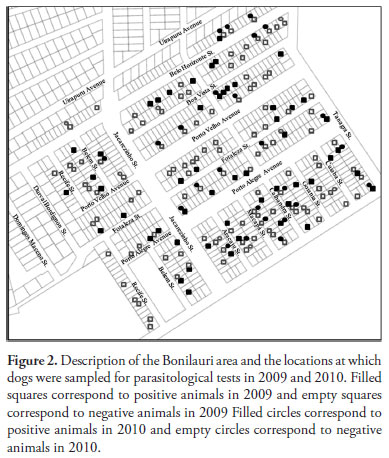Domestic animals in urban areas may serve as reservoirs for parasitic zoonoses. The aim of this study was to monitor the parasitic status of household dogs in an urban area of Pinhais, in the metropolitan region of Curitiba, Paraná State, Brazil, after a one-year period. In May 2009, fecal samples, skin scrapings and ticks were collected from 171 dogs. Questionnaires were applied to the owners (sex, age, environment and anthelmintic use). In May 2010, 26.3% (45/171) of the dogs were fecal samples reanalysed. From the fecal samples, 33.3% (57/171) in 2009 and 64.4% (29/45) in 2010 were positive. The parasite species most observed were, respectively in 2009 and 2010, Ancylostoma sp., 66.7 and 44.8%, and Strongyloidesstercoralis, 26.3 and 3.4%. All the skin scrapings were negative, and no ticks or protozoa were found. There was no statistical association (p > 0.05) between positive fecal tests and age, sex or environment. In 2009 alone, dogs with a history of antiparasitic drug administration were 2.3 times more likely to be negative. A great number of replacement dogs was noticed one year later. Therefore, isolated antiparasitic treatment strategies may have no impact on parasite control, given the risk of introduction of new agents, thereby limiting the prevention strategies.
Dog; parasitism; helminth; public health; zoonosis



